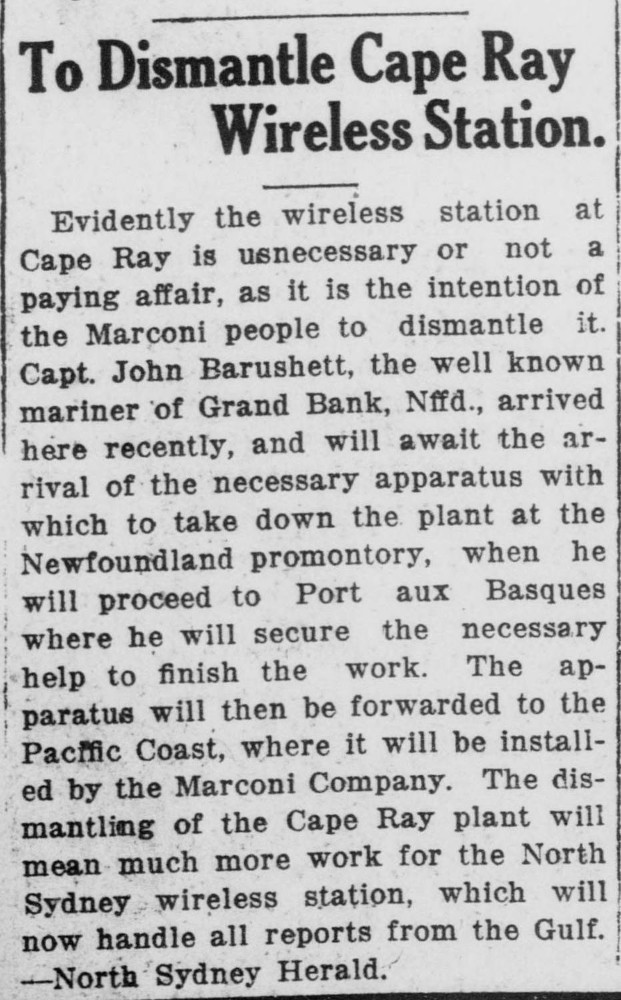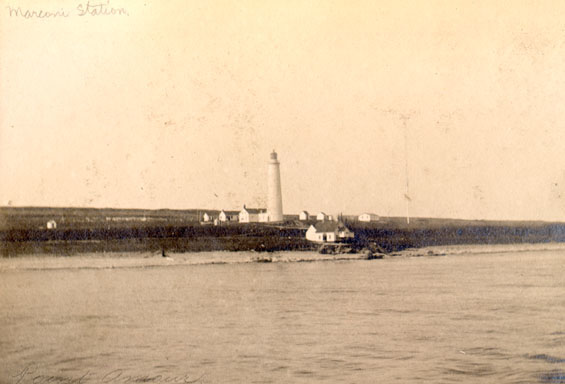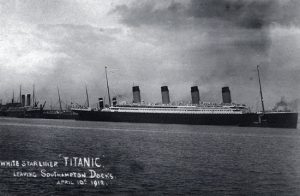Canadian Stations
Between 1901 and 1904, the government of Canada hired the CMC to build five stations in Newfoundland and in Labrador. In addition to the one on Belle Isle, they were built at Cape Race, Cape Ray, Point Amour, and Point Riche. Their primary purpose was to communicate with shipping traffic. Their secondary purpose was to connect wireless radios (on land or sea) to the wired telegraph network. Ships and remote communities could communicate with them via radio, and the stations could send along the messages through the wires.
The Anglo-American Telegraph Company (AATC) still had a monopoly on all telegraphy in Newfoundland at this time. It is unknown why the Canadian government was allowed to build these five stations. One explanation is that Canada already operated services in Newfoundland. The Cape Ray station was added to a lighthouse that was on Newfoundland soil but was operated by Canada, for example. Another explanation is that the AATC did not want to take the government of another country to court. Regardless, the AATC did not interfere with the construction of these stations.
Cape Ray
The Trinity House of Quebec was an organization that worked to make shipping and trading safer along the St. Lawrence River and in the Gulf of St. Lawrence. They did this by building lighthouses. The government of Newfoundland offered Canada a small piece of land at Cape Ray for this purpose.
The Canadian government built a lighthouse at Cape Ray in 1871 and added wireless equipment to it in 1901. It is unclear precisely when the wireless station began operations, but it closed in 1922. The station in North Sydney, Nova Scotia, took over Cape Ray’s responsibilities and its wireless equipment was used to upgrade the Point Amour station.
Point Riche
Not much is known about the Point Riche wireless station. It opened in 1904 and acted as the first point of contact for ships approaching the Strait of Belle Isle from the south and west. This station closed in 1922 and sent its equipment to Point Amour. Closing stations and sending their equipment to upgrade another station was a common practice. As radios got more advanced, stations could transmit across longer and longer distances. This meant that Newfoundland and Labrador needed fewer stations, so the government began to close some.
Point Amour
As with Point Riche, not much is known about the Point Amour wireless station. It most likely opened in 1904. The Canadian government built the station on the Labrador side of the western entrance to the Strait of Belle Isle. The Point Amour station played an important role in helping ships navigate the narrow passage. For this reason, it received parts from the stations closed in 1922. Point Amour remained in operation until the 1960s.
Cape Race
The Cape Race wireless station began service on November 17, 1904. It had one of the longest ranges of any station in the colony. When it opened, it had a range of 300 to 500 kilometres. By 1914, it had increased to 800 kilometres. At the southeastern corner of Newfoundland, it was the first point of contact for vessels sailing to New England or Canada from Europe.
The two main uses of wireless stations were to communicate with ships and to relay messages. Both were famously performed at Cape Race in the spring of 1912. On April 14 that year, the RMS Titanic struck an iceberg near the Grand Banks, 630 kilometres from the Cape Race station. The RMS Carpathia received their distress signal and hurried to the site.
The Cape Race station also received the distress signal. Wireless operators Walter Gray, Jack Goodwin, and Robert Hunston relayed the message on to shipping authorities and others.
The Cape Race station made the world aware of the great tragedy. Thanks to these actions, New York’s Pier 54 had the time to be equipped and ready to receive more than 700 survivors and provide them with emergency care. When all were accounted for, more than 1,500 people were on the “did not survive” list. For weeks after the disaster, the Cape Race station was flooded with messages inquiring about what had happened.
On May 5, 1913, the Cape Race station burned down. Since it had proven itself useful, however, the CMC had a temporary station installed within two days. The permanent station reopened in less than four months. The station closed in 1930 and was dismantled in 1965. The CMC used its equipment to upgrade a direction-finding station.




